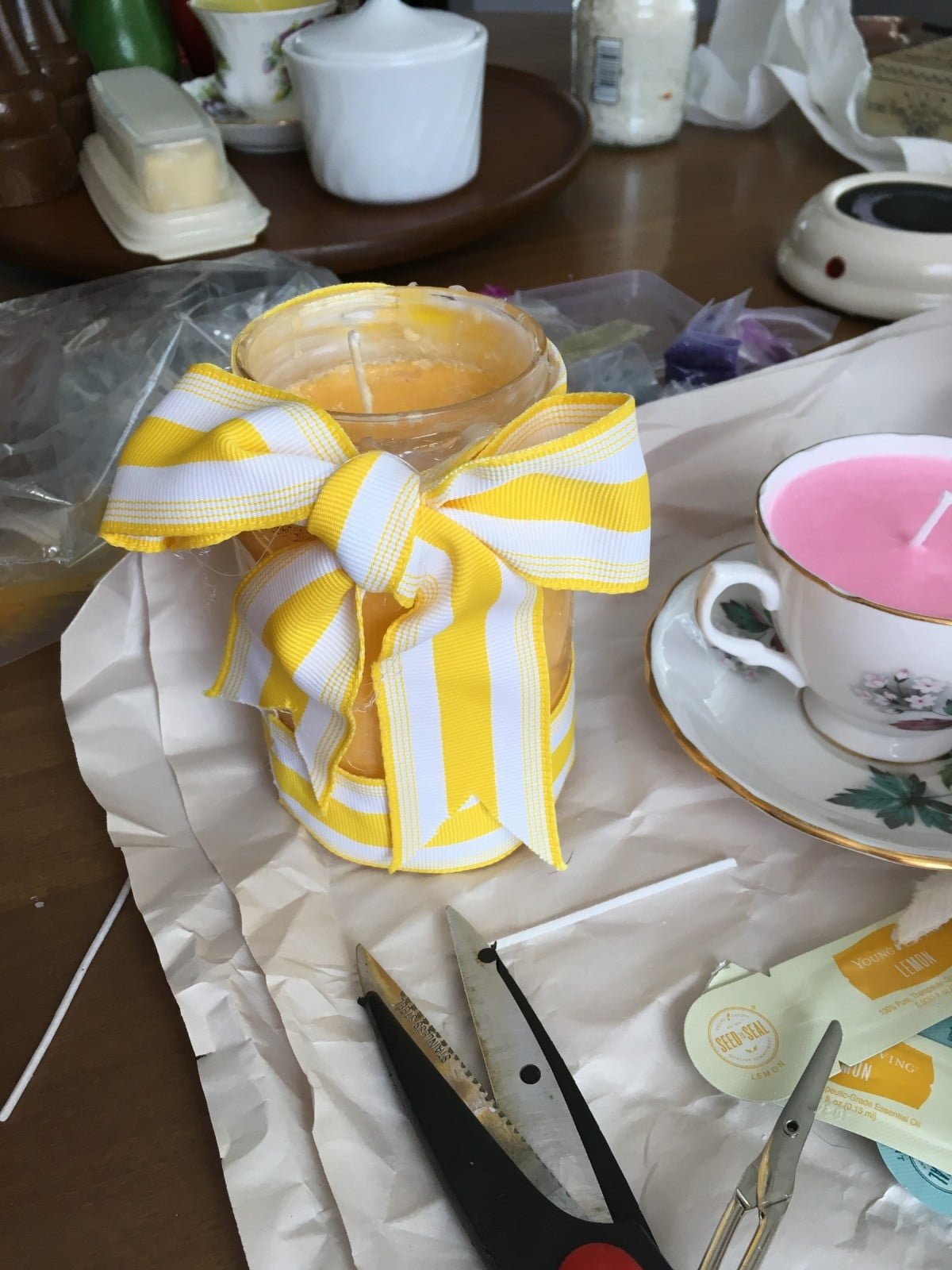Beeswax and soy wax are both used in candle making. Beeswax is a natural product produced by honey bees, while soy wax is a plant-based wax made from hydrogenated soybean oil. Though both have their own benefits when used for candle making, it’s important to understand how they’re made in order to have the best possible candles crafted with them.
Beeswax is primarily collected from worker bees and queen bees’ brood cells or nesting holes where honey or food can be stored by the bee hive. To make the beeswax usable for candle making it needs to be rendered and processed which involves melting it and straining out impurities like debris and foreign material. After this process, the melted wax is ready to be poured into molds which will become your candles or DIY projects.
While beeswax can often provide more of a “natural” scent to your space compared to other types of wax, soy offers some of its own unique advantages. Soy has been widely used as an alternative candlemaking ingredient due to its ability to hold fragrance well and burn longer than beeswax (up to 50% longer).
Soy wax also burns slower so experiencing little waste overall or sooting is typical when using this type of wax for your homemade creations. To make soy wax one takes carefully harvested soybeans, purifies them through cold pressing techniques and finally turns these into flakes that can easily be melted down into warm liquid form before crafting candles with them.
Conclusion To sum up, even though both types of wax – beeswax and soy – offer different advantages for candle making there is no right or wrong option when deciding which one suits you better as a crafter. Some people might prefer ones’ naturalness while others might rather benefit from measured fragrancesReleased throughout their interior space during burning time – all depending on individual preferences.
Thus having the proper information on how each type of wax is made beforehand should help everyone make informed decisions about what works best for them going forward.
Pros and Cons of Beeswax vs. Soy Wax
Beeswax is naturally derived from honey bodies, making it a sustainable and renewable option for candle making. It’s also known to burn slower and longer than soy wax, and has a pleasant fragrance to it that can often suitably replace artificial fragrances.
Additionally, beeswax has been found to help purify the air when burned – by releasing negative ions which tap into dust and other pollutants in the air. In terms of composition though, beeswax is quite stiff – making it difficult for some beginners to work with, due to it not being as malleable as other waxes like soy.
Soy wax on the other hand can also offer several benefits for candle makers – one being its affordability. A natural wax derived from vegetable oil, soy produces long-lasting candles with minimal soot residue during burning compared to paraffin or petroleum-based candle waxes.
It is also easy to work with and melts quickly – meaning all you need is an old pot or double boiler to melt it down completely. Alongside this, Soy wax also allows for more acute decoration and design possibilities than Beeswax does – such as adding colour pigmentation with greater ease as no extra additives are required in the process.
Ultimately, whether you opt for Beeswax or Soy Wax really comes down down preference and intended usage too – such as Candle type (taper candles, pillar candles etc. ), size requirements etc.
Soy Wax works better for certain tasks over Beeswax such as votives or tealights which have a container that requires melting evenly throughout every corner of them; as wellas carving complex shapes since it holds shape better whilst cooling down compared Beeswax which may bend out of shape more easily once hardened due to its stiffness/hardness in composition and difficulty of workability when cold.
Types of Candles Possible With Each Wax Material
- Beeswax – can be used to make all types of candle including traditional pillar candles, floating, tea lights, scented and novelty candles.
- Soy wax – is a flexible material made from vegetable-based oils that can be used in the production of soy container candles, scented or religious candles. Soy also works well for votives and tealight holders.
Differences in Quality and Burning
Beeswax is thought of as being superior to other waxes because it burns cleanly with a low melting point and does not need additives or chemicals. Its quality is also superior as it makes the finished candle look glossy and beautiful. The burning time is often longer than other waxes as it has a slower melting point which helps enhance scent retention.
Soy however, is considered more eco-friendly because it creates very little smoke when burnt. The slow burning time makes soy an excellent choice for private rituals where extended burning is needed like outdoor events or large gatherings.
The downside to soy is that it has a creamy colour so if a white or clear finish for votive candles is desired then beeswax should be used instead. In addition, soy can sweat in warm temperatures which then may require additives like stearic acid to prevent this from happening.
Price Comparison Factors
In terms of cost both waxes are competitively priced when considering volume purchasing. What buyers should consider however, are the following factors; Firstly, in order to keep beeswax costs down one needs access to beekeepers who produce large enough quantities all year-round at discounted prices.
Secondly, soy requires heaters and containers during use which will add an additional expenditure to the estimated cost per unit price; whereas beeswax does not need any additional equipment during its production process. Lastly, depending on usage requirements this will influence pricing likely of either product type since different suppliers offer various discounts levels beyond fair trade minimums on bulk buys.
Different Fragrances Available for Each Wax Variety
Beeswax is a beloved candle making wax by many home crafters and industry professionals alike. Beeswax candles are known to be incredibly beautiful, natural, and of course highly organic. Not only do they support the bee population, but they also produce a beautiful honey aroma. In terms of burning properties and making process, beeswax has very similar characteristics to soy wax.
It has a high melting point so it burns slower than other waxes, resulting in an even wax pool that minimizes smoke or soot. However, beeswax also tends to be more expensive than other wax varieties such as soy. It also may not always hold colorants as well as other waxes depending on its thickness.
Soy wax has become increasingly popular for candle makers in recent years because of its affordability and convenience when compared to beeswax. It’s made from 100% natural soybean oil and is non-toxic if burned correctly (unlike paraffin). With its low melting point, it melts quickly and creates soft edges on the sides which makes for a smooth finish after pouring your candle.
Soy candles are known for having excellent scent throw and can contain any variety of fragrance that you desire – although you should avoid using fragrances that are too strong with this kind of wax. Because it’s less dense than beeswax, it won’t necessarily last as long when lit – sometimes only four hours or less.
Both bee’swax and soy candles provide different benefits based on what you are looking for in the end product. For instance, if you’re looking for a slow burn time then beeswax will probably give you that while soy might be more suited to people who prefer quick easy results when making their candles.
Fragrance throws may be weaker with some varieties of either type of candle so selecting the right one would require testing them out before selling or gifting them; therefore smell-testing any given type is important prior to committing to make multiple sets of those desired candles.
Scented vs. Unscented Candles
When it comes to deciding between beeswax and soy wax for candle making, one of the main considerations is whether you want your candle to be scented or unscented. Beeswax candles tend to take on a slight natural honey scent, which is perfect for creating subtle aromatherapy-like effects without having to add any additional fragrances.
Soy wax does not have any inherent scent so if you are looking for a fragranced candle, you will need to use a combination of fragrance oils and waxes. The great thing about soy wax is that it has a very clean melting point and can hold onto more fragrance oil than beeswax.
Melting Temperature
The melting temperature of the wax can also be a determining factor when choosing between soy and beeswax for candle-making. Beeswax has a slightly higher melting temperature than soy wax, so it takes longer to melt down completely – this can make the process of spooning out molten wax easier.
On the other hand, soy wax melts more quickly than beeswax but requires an even heat source in order to melt properly. This means that heat diffusers are often necessary when using soy wax which adds extra time and cost onto production.
Cost Difference
The cost difference between beeswax and soy wax is also worth considering when making your decision as well. Generally speaking, soy wax tends to be significantly cheaper than beeswax due to its abundant availability; however, the cost savings may not necessarily equate to value for money when compared with the performance features of beeswax (longer burn times, strong scent throw etc).
Depending on your budget constraints then either option could work well – but for those who are serious about their craft then stock up on good quality ingredients no matter what type of candle you plan on making.
DIY Candle Making Projects
When it comes to do-it-yourself (DIY) candle making projects, choosing the right wax is one of the most important decisions you can make. There are many types of wax available, from beeswax to soy wax, and understanding which is best for your project is essential. In this article, we’ll explore the differences between beeswax vs soy wax in terms of pros and cons:
Beeswax
- Pros: Burning beeswax candles tends to release negative ions and remove pollutants from the air. Additionally, they have a naturally sweet floral aroma that adds an extra dimension to any DIY candle project.
- Cons: Beeswax is more expensive than other waxes and may not be ideal if you want to create a large number of candles on a budget.
Soy Wax
- Pros: Soy wax is affordable, non-toxic and vegan friendly. It’s also highly versatile for DIY projects; soy wax can be used to make different sizes and shapes of candles.
- Cons: Soy loses its scent quickly while burning; therefore, if you want your candle to have a strong scent or throw, consider using another type of wax such as beeswax.
Both types of wax offer advantages and disadvantages for DIY candle makers; ultimately which one you choose will depend on what kind of look/scent/usage you’re aiming for with your project. By understanding the differences between them, you can determine which option works best for your needs.
Creating Specialty Candles
Creating specialty candles with beeswax or soy wax has become increasingly popular as a hobby. The differences between these two waxes offer unique characteristics for those who are passionate about the craft.
Beeswax
Beeswax is a natural wax derived from honeybees. Its purity and light sweetness create very special candles which emit a pleasant aroma when they burn, as the scent of honey and floral notes tend to linger in the air. It’s hard-textured so it gives off an enchanting pale golden hue as well.
Due to its hard consistency, beeswax can be used to make more intricate designs with sharp ridges and points. Also, because of its tough nature the heat produced by burning the beeswax candles is stronger than that given off by other types of candle waxes meaning they will last longer with a clean burn and minimal soot build up on or around them.
Soy Wax
Soy wax is created by a hydrogenation process that alters soybean oil into a soft waxy substance much like vegetable shortening would look like if solidified. Soy wax is not derived from bee’s byproducts so vegans can use this in order to enjoy candle making without guilt or consequence.
Unlike beeswax, soy is softer and more pliable making it easy to work with when making irregular shaped candles such as odd containers or molds with multiple angles or shapes that would prove difficult using beeswax instead.
Additionally, because of its soft texture most soy-based scented waxes have little to no residual scent left once the candle has been burnt out, however the initial burning will give off a pleasant smell similar to cooking oil giving off their signature smell usually consisting of vegetables and herbs such as onions garlic etcetera from cooking in its general vicinity.
Besides offering an affordable alternative to expensive paraffin based candle wax soy also burns cleaner than beeswax leaving behind less waste therefore decreasing your eco-footprint considerably when it comes time for disposal after many hours of enjoyment have passed at home or elsewhere you may have enjoyed your specialty candle creations.
Common Candle Making Mistakes
1. Not testing candle for proper burning When making a candle, it is important to ensure that the burn rate of the candle is correct according to safety guidelines. Without proper testing, your candles may burn too quickly or slowly, or the wicks may not stay lit long enough.
This can pose a safety hazard. To test your candles, start by lighting them in small batches and timing how quickly they melt and how long they stay lit. If you find the candles are not burning correctly, you may need to adjust some of the proportions of your ingredients before moving onto larger batches.
2. Using too much wax additive Candle makers often add additives such as colouring, scent or shiny glitters when making their candles to give them a desirable look and smell.
However, if too much of these additives are included in the recipe then this can cause problems with how well the candle burns due to an imbalance between liquid wax and solids in the wax mixture desired for optimal burning characteristics. It’s important to always reference measurements accurately when adding components such as fragrances or glitter so that it does not exceed more than 10-15% total volume of all ingredients used in a given recipe.
3. Using improper wick size The size of wick used when making a candle is just as important as any other ingredient added in its creation process – using an improperly sized wick can lead to short-burning times or potentially dangerous flames if too much fuel is fed into the flame at once while burning.
It’s important to research and test various thicknesses of wicks first before using them for an entire batch; this will ensure that you select one compatible with other ingredients used so that optimal burning performance is achieved once lit up.
How To Troubleshoot Common Candle Making Problems
Beeswax or soy wax are popular options when making candles, however what is the difference between these two and which one should you use? Soy wax has a slight lower melting point than beeswax, which makes it easier to pour into your molds or tins. It also gives off less smoke and soot than natural waxes such as paraffin and beeswax.
Further, it is known for its creamy white appearance that helps bring out the true color of even the darkest pigments. However, if you’re looking for a longer burning time then you may want to consider beeswax instead as it has a higher melting point and thus produces longer-lasting candles.
Whichever wax you choose to use in your candle-making there are some common problems that people have reported when trying to make their own candles. The first problem many people report is that their wicks do not burn properly, or appear too ‘short’; this usually means that there isn’t enough fuel in the candle container for the wick to burn correctly.
This can be easily solved by twisting the core slightly after pouring your melted wax into the opening of the container. Make sure to leave space at the top of your container so that more air can reach your flame.
The second issue people may encounter is poorly burned candle tops; this happens when either too much heat is used when understanding the candle or no postprocessing was done after pouring the wax into the molds or containers. To ensure this doesn’t happen you should always make sure to temper your temperature before pouring while using a thermometer for exact control over how hot the wax gets.
Failing that you can also give your candles a ‘roll’ after they harden but before entirely cooled down in order to break up any sharp edges caused when cooling from hot temperatures quickly. Lastly, ensure that there are no voids present in your mold where pooled wax could sink by tapping gently on each side – if you hear nothing then your mold was poured correctly.
Conclusion
When it comes to candle making, there are many types of waxes that can be used. Beeswax and soy wax are two popular choices for a variety of different reasons. Both waxes have their own unique properties and advantages that make them great for crafting candles. First, let us examine the differences between beeswax and soy wax.
Beeswax is derived from the honeycombs of beehives where it is collected, then filtered and melted down into blocks or pellets which can then be used in candle making. One great thing about beeswax is that it has natural aromatic qualities, so when you melt it down, you get a naturally sweet smell that enhances the overall aroma of the candle itself.
Beeswax also burns very slowly compared to other forms of waxes so your candles will last longer and burn cooler than those made with other materials. Beeswax also tends to hold Colors exceptionally well too so you can craft beautiful candles without worrying about colors fading or bleeding away quickly like they would with some other types of waxes.
Soy wax, on the other hand, is sourced from soybeans that have been cold-pressed into small flakes or granules before they’re processed into solid blocks ready for melting in candle making applications. Soy does offer a clean burning experience as it helps you achieve excellent scent throw due to its smoother consistency.
Additionally, soy contains no toxins – meaning your candles won’t emit any harmful byproducts into the air after burning – whereas beeswax may if not filtered properly beforehand (because of the pollen particles within).
Furthermore, soy isn’t known to clog up wick holes as much as beeswax sometimes might so this also means better flame control when burning candles crafted with soy eggs Lastly, soy is easy to clean out of containers due to its low melting point; simply microwaving jars at short intervals will do the trick.
So now you know a little bit more about both beeswax and soy wax for candle making purposes there’s really no wrong choice between them both as long as they’re handled correctly alongside quality wicks. For those looking for a slow burning candle with an enjoyable aroma: go withbeeswax. Those wanting an eco-friendly approach alongside controlled flames can choose to use soy instead Regardless, both offer excellent value for money dependent upon individual budget considerations Happy crafting.

Welcome to my candle making blog! In this blog, I will be sharing my tips and tricks for making candles. I will also be sharing some of my favorite recipes.





